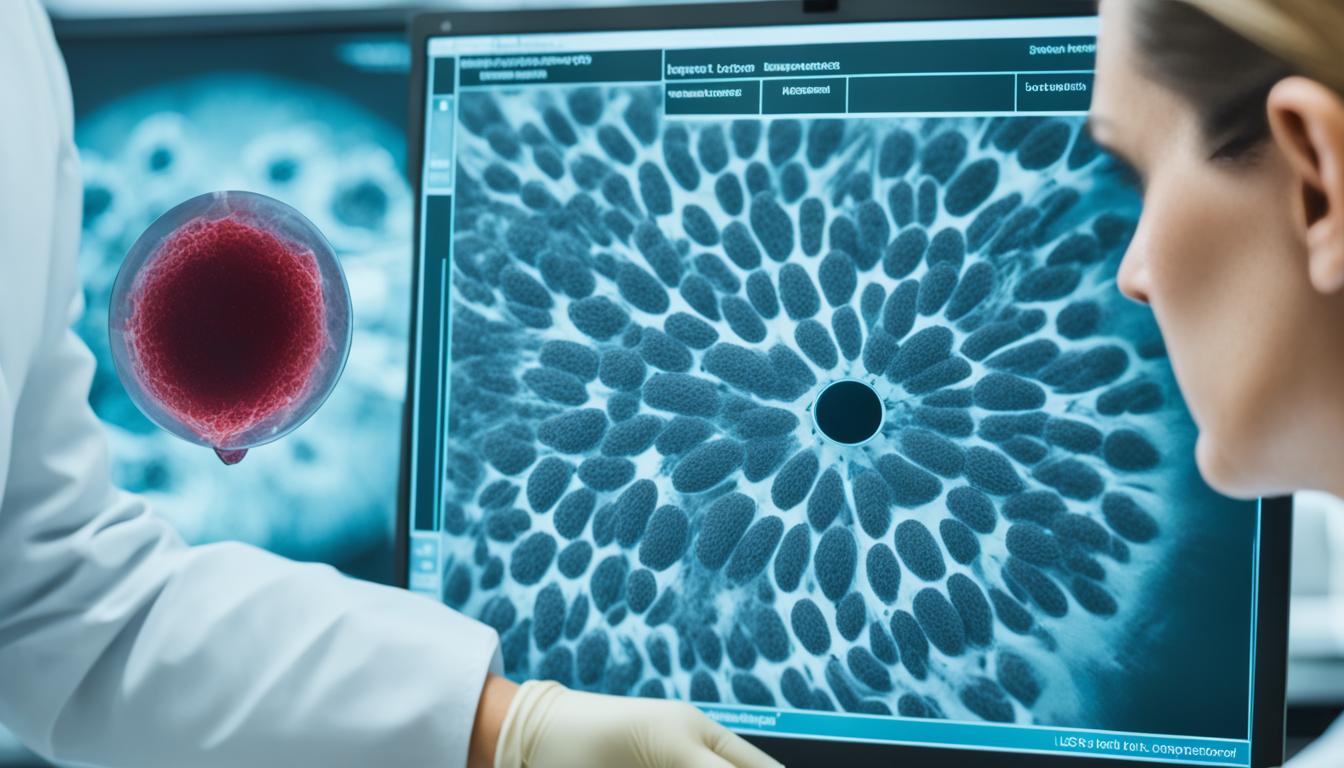Lobular carcinoma in situ (LCIS) is a breast abnormality. It marks an increased risk of later developing invasive breast cancer. This issue spreads throughout the breast tissue.
It might appear in both breasts at the same time. Around 25% of LCIS patients might face invasive breast cancer within 25 years of diagnosing LCIS.
The present ways to handle LCIS include watching after an excisional biopsy. Or using anti-estrogens like Nolvadex to lower the cancer risk is an option. Anti-estrogen treatment can cut the risk by 45% in high-risk women.
But, using anti-estrogens has downsides. They might raise the chances of endometrial cancer and blood clots. So, it’s a balancing act.
It’s crucial for women with LCIS to keep up with checks like mammograms or CT scans. This helps spot any changes early. Early detection means healthcare pros can step in with the right help sooner.
Key Takeaways:
- LCIS is an abnormality in the breast that increases the risk of developing invasive breast cancer.
- Approximately 25% of patients with LCIS will develop invasive breast cancer within 25 years of diagnosis.
- Observation after an excisional biopsy or treatment with anti-estrogens are the current approaches in managing LCIS.
- Anti-estrogen treatment has shown a 45% reduction in the development of breast cancer in high-risk women.
- Regular medical examinations, mammograms, and imaging scans are crucial for monitoring any changes or progression in LCIS.
Diagnosis and Screening for LCIS
Diagnosing LCIS usually involves a breast biopsy. A small piece of tissue is taken out for study. This could be by a core needle method or by surgery. Doctors then check if it shows LCIS signs.
Unfortunately, mammograms are not great at finding LCIS. But women with LCIS should still get regular mammograms. This is to watch for tissue changes and any odd things in the breast.
Women may also get CT or MRI scans now and then. These give more info about the breast, helping doctors see more details and understand how far the disease has spread.
Doctors often also test for ER and PR, called breast tumor markers. These show if LCIS will react well to hormonal treatments. Knowing the markers helps doctors plan treatments that are right for the patient.
Regular Breast Screening for LCIS
Women with LCIS need to have regular breast screenings. This checks for any new issues or signs of cancer. Even though mammograms don’t find LCIS well, they’re still key for check-ups. Every year, they alert to any new problems.
Sometimes, CT or MRI scans are also needed. They give more detailed pictures of the breast. These tests are done sometimes to check things more closely.
Importance of Breast Tumor Markers
Breast tumor markers, like ER and PR, help a lot. They were vital in deciding the best treatments. For example, if LCIS is ER-positive, it might do well with therapies that target estrogen.
On the other hand, PR-positive LCIS means it might respond to progesterone-targeting treatments. This information guides tailored treatment plans.
Looking at tumor markers helps doctors create plans that fit each patient’s LCIS. This way, treatments work better and can lead to more positive results.
Thanks to better diagnostic tools and markers, LCIS management has improved. Regular screenings and studying tumor markers are crucial. They help in reducing the risk of invasive cancer and in treating LCIS effectively.
Advances in the Treatment of LCIS
Researchers are looking into new ways to treat LCIS, a condition linked to breast cancer. They are studying the benefits of hormonal therapies, targeted treatments, and stem cell therapy.
Hormonal treatments, like anti-estrogens, are getting attention. They cut the risk of breast cancer in LCIS patients at higher risk. These therapies stop estrogen’s effect on our bodies. This can halt cancer cell growth. Clinical trials are crucial for testing new drugs and approaches. They let patients try out potentially better treatments.
Today, targeted treatments are a key focus. They aim to hit only cancer cells or their surroundings. This means less harm to healthy tissue. By studying LCIS closely, new targeted methods are being found. These could lead to treatments designed just for the patient. This approach may prove more effective in fighting LCIS.
Looking at stem cell therapy, it’s also a promising field. Stem cells can turn into different types of cells, including those in the breast. This hints at a future with treatments that regenerate and heal.

